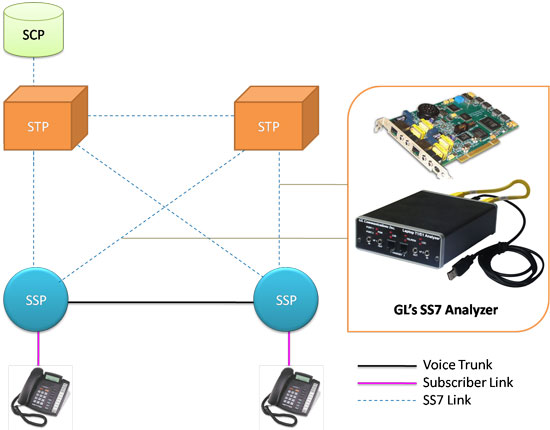Newsletter: GL Releases SS7 Protocol Analyzer with INAP CS-2 Decode
Welcome to another March 2009 issue of GL's Newsletter providing information and insight into our SS7 Protocol Analyzer, recently enhanced with INAP CS-2 Decoding capability.
SS7 and INAP (Intelligent Network Application Part) permit intelligent features to be added quickly to PSTN and mobile networks without affecting transmission and switching portions of the network. Examples of intelligent features are "toll free numbers" "number portability", and "pre-paid telephone calls". Capability Set 2 (CS-2) is an enhancement over Capability Set 1 (CS-1).

Overview
SS7 (Signaling System 7) separates the information required to set up and manage telephone calls in the Public Switched Telephone Network (PSTN) onto a separate packet switched network (Signaling Network). The main protocols include MTP (Message Transfer Part - Level 1 to 3), SCCP (Signaling Connection Control Part), and ISUP (ISDN User Part).
GL supports Real-time, Off-line and Remote SS7 protocol analyzers and in Real-time and Off-line analysis, information is presented in the following layers:
- Raw HDLC Frame data as a hexadecimal and ASCII octet dump
- MTP2 and MTP3 information
- ISUP, TUP, SCCP etc. information
Different SS7 layers like MTP2, MTP3, ISUP, TUP, SCCP, INAP (CS1, CS2) and many application layer protocols from GSM/GPRS network like MAP, CAMEL(CAP), IS 41 etc are decoded according to ANSI/ITU/ETSI standards and displayed in an organized fashion.
INAP CS-1 and CS-2 Codec Decoding Support:
GL's SS7 Analyzer is capable of decoding INAP Protocol (Capabality Set-1 and Capability Set-2) and it supports both ITU and ETSI standards.
INAP - CS1 was standardized first for Intelligent Networks and INAP - CS2 was a successor that has added features. With the addition of INAP CS-2 decoding, GL's SS7 Analyzer can now support decoding of SCF initiated trigger management, GVNS service support, explicit ISDN supplementary service feature interaction support, service compatibility checks, general User to Service Interaction (UTSI), and extended BCSM support.
Some of the Important Features:
- Displays Summary, detail, hex-dump, statistics, and call trace views
- Summary View displays MTP2, MTP3 information and SS7 Message types, Called and Calling number, SCCP message type, SSN, INAP information, and more in a tabular format
- Detail view displays decodes of a user-selected frame from the summary view
- Capable of decoding many important protocols from GSM/GPRS network i.e. MAP, CAP.
- Hex Dump view displays the frame information in HEX and ASCII format
- Statistics view displays call and MSU statistics at any link or entire link set
- Call trace isolates call specific information i.e. status of each call (i.e. active/completed), duration of completed
Some of the additional features supported by real-time/remote SS7 Analyzer are:
- Real-time filter and search features on various SS7 message types
- Streams can be captured on the selected time slots (contiguous or non-contiguous), sub-channels or full bandwidth. Frames may also be contained in either one, n x 64 kbps, or n x 56 kbps data channels
- The following variations are accommodated in the software: inverted or non-inverted data, byte reversal or non-reversal
- Supports decoding of frames with FCS of 16 bits and 32 bits, or none
- Recorded trace files can be played back using HDLC Playback application
Some of the additional features supported by offline SS7 Analyzer are:
- Trace files for analysis can be loaded through simple command-line arguments
- Multiple trace files can be loaded simultaneously with different GUI instances for offline analysis
For comprehensive information on the product, please refer to SS7 Protocol Analyzer web page.
 Back to Latest News Page
Back to Latest News Page